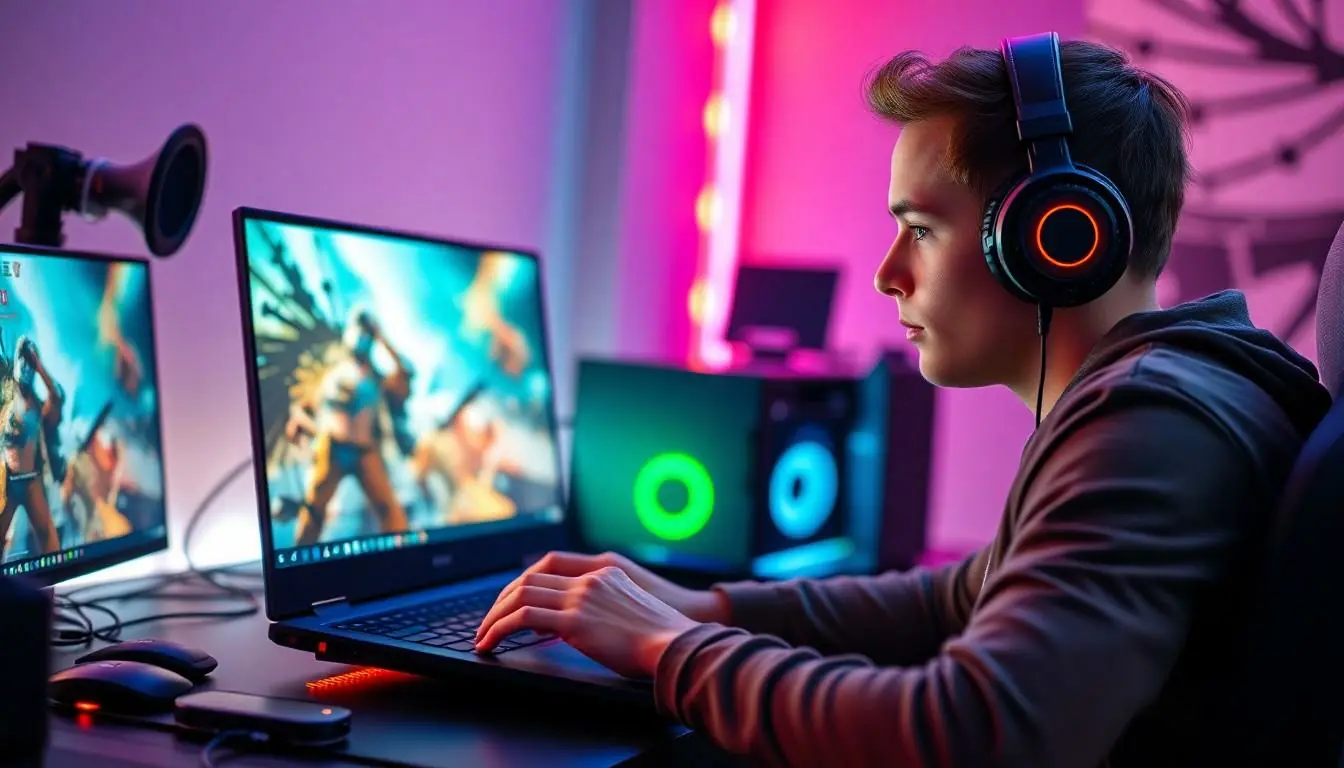In the world of gaming and high-performance tasks, every frame per second (FPS) counts. Imagine your laptop chugging along like a tortoise while your favorite game runs at a snail’s pace. It’s enough to make anyone want to throw their laptop out the window—don’t do that! Instead, let’s dive into some simple tips and tricks that can help your laptop unleash its inner speed demon.
Table of Contents
ToggleUnderstanding FPS and Its Importance
FPS, or frames per second, refers to the number of individual frames displayed in one second of video. High FPS delivers smooth visuals, enhancing gaming and multimedia experiences. Players often experience a competitive advantage when their systems support higher frame rates, resulting in quicker reactions and improved in-game performance.
Performance metrics indicate significant differences between low and high FPS. For instance, frame rates below 30 cause noticeable stutters, detracting from gameplay. Frame rates between 30 and 60 provide an average experience but may still include some lag during intense action scenes. Frame rates above 60, especially 120 or more, create fluid motion that gamers increasingly prefer.
Many laptops fall short in delivering optimal FPS due to hardware limitations. Integrated graphics often struggle under demanding applications, which can lead to frustration. Upgrading hardware components, such as RAM or the graphics card, often results in notable improvements in FPS.
Optimizing settings within games can also impact performance. Reducing texture quality or turning off special effects enhances FPS without sacrificing quality drastically. Additionally, keeping drivers updated guarantees better compatibility with emerging software and improved performance.
Monitoring FPS through software tools can help users identify performance bottlenecks. An FPS counter provides real-time data, enabling users to adjust settings effectively for the best experience. Recognizing FPS fluctuations allows for targeted troubleshooting, whether addressing software conflicts or hardware constraints.
Prioritizing higher FPS elevates overall user satisfaction. Gamers especially value the increased responsiveness and dynamic experience that comes with improved frame rates. Understanding FPS serves as a crucial step toward enhancing laptop performance during gaming and other demanding tasks.
Common Causes of Low FPS on Laptops
Low FPS can stem from several factors that impact laptop performance. Identifying these causes can significantly enhance the overall gaming experience.
Background Processes
Excess background processes consume valuable CPU and memory resources. Operating systems often run various applications in the background, hindering performance. Heavily loaded task managers indicate how many processes are actively affecting FPS. Users can close unnecessary programs and disable startup applications to free up resources. Reducing the number of active processes often leads to improved frame rates during gaming sessions. Regularly checking background activities helps maintain optimal performance for demanding tasks.
Graphics Settings
In-game graphics settings directly influence FPS on laptops. High-resolution textures, shadows, and anti-aliasing can overload hardware capabilities. Adjusting these settings to a mid-range or low level can yield smoother gameplay. Players may find that decreasing resolution or turning off demanding visual effects leads to noticeable improvements. Balancing visual quality with performance is essential for achieving higher FPS. Testing various settings allows users to tailor their gaming experience for peak performance.
Tips to Increase FPS on Laptop
Improving the FPS on a laptop requires several practical steps that enhance performance. Below are several strategies that can lead to significant improvements.
Update Graphics Drivers
Keeping graphics drivers current provides vital performance benefits. Outdated drivers can hinder a laptop’s ability to utilize available hardware effectively. Users need to visit the manufacturer’s website regularly to download the latest updates. Regularly updating drivers can fix bugs and optimize performance in games. Manufacturers often release updates that enhance compatibility with new software, improving FPS in the process.
Optimize Game Settings
Tweaking in-game settings helps achieve smoother gameplay. Users should lower graphics settings such as texture quality and shadows for better performance. Selecting a resolution that matches the laptop’s capabilities can significantly enhance gameplay fluidity. Many games offer presets that balance visual quality and performance effectively. Experimenting with these settings allows users to find the right balance for their hardware and game preferences.
Adjust Power Settings
Configuring power settings can maximize performance during gaming sessions. Users should set the laptop to high-performance mode to ensure maximum resource allocation. High-performance settings prioritize CPU and GPU usage over optimizing battery life. Users might also disable power-saving features that limit the performance of the laptop during demanding tasks. Adjusting these settings can lead to a direct increase in FPS during gameplay.
Clean Up Your System
Cleaning up the system helps improve overall efficiency. Removing unnecessary programs and files restores valuable resources. Users should regularly check for malicious software that can drain performance. Disk cleanup tools can help free up space by eliminating temporary files that clutter the system. A clean and organized system ensures that more resources are available for gaming, leading to higher FPS.
Advanced Techniques for Boosting FPS
Advanced techniques offer additional ways to enhance FPS on laptops. These methods often involve hardware adjustments that lead to substantial performance enhancements.
Overclocking Your GPU
Overclocking a laptop’s GPU can produce significant gains in frame rates. This process involves increasing the graphics card’s clock rate beyond its standard speeds. Many gaming laptops come with software tools that facilitate overclocking. Users should monitor temperatures closely to prevent overheating, as increased speeds can generate excess heat. Adjusting GPU settings through these tools allows for fine-tuning performance based on specific gaming requirements. Risks accompany this method, so proceeding with caution is essential.
Adding More RAM
Inserting additional RAM can dramatically improve a laptop’s FPS. Many laptops come equipped with only a standard amount of memory, limiting performance during demanding tasks. Upgrading to 16 GB or more enhances multitasking capabilities and supports higher graphics settings. Higher RAM capacity enables the system to store and process data more effectively. This upgrade reduces stuttering and increases overall system responsiveness. Users should ensure compatibility with their existing hardware before purchasing new RAM modules. Investing in additional memory often results in a smoother gaming experience, making it a worthwhile enhancement.
Conclusion
Increasing FPS on a laptop can transform the gaming experience and enhance overall performance. By implementing the strategies discussed, users can optimize their systems for smoother gameplay and better responsiveness. From updating drivers to adjusting in-game settings and even considering hardware upgrades, every step contributes to improved frame rates.
It’s essential to monitor performance regularly and make necessary adjustments based on individual needs. With a little effort and the right techniques, anyone can elevate their laptop’s capabilities, ensuring a more enjoyable and competitive gaming environment. Prioritizing these enhancements not only satisfies gaming demands but also boosts productivity in high-performance tasks.





